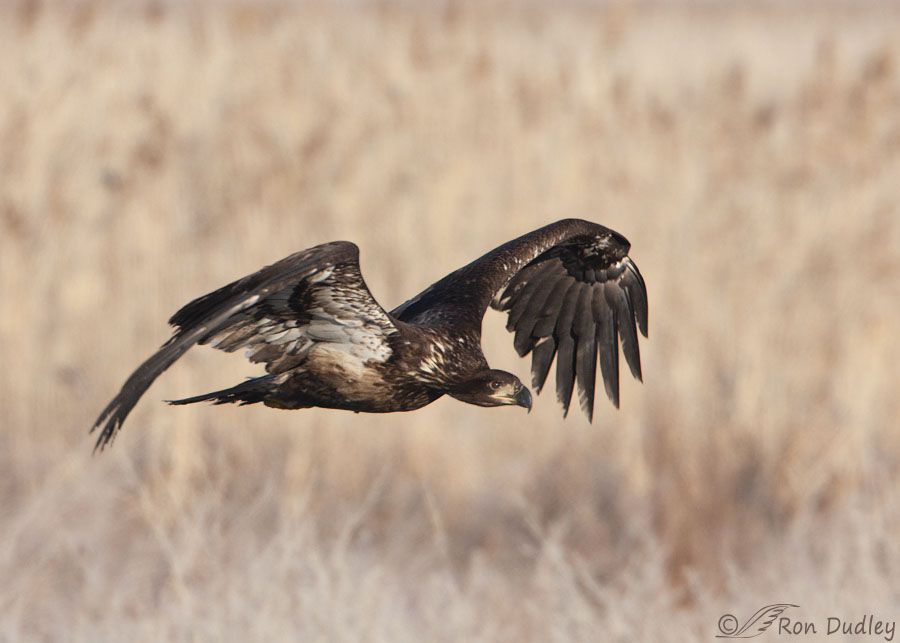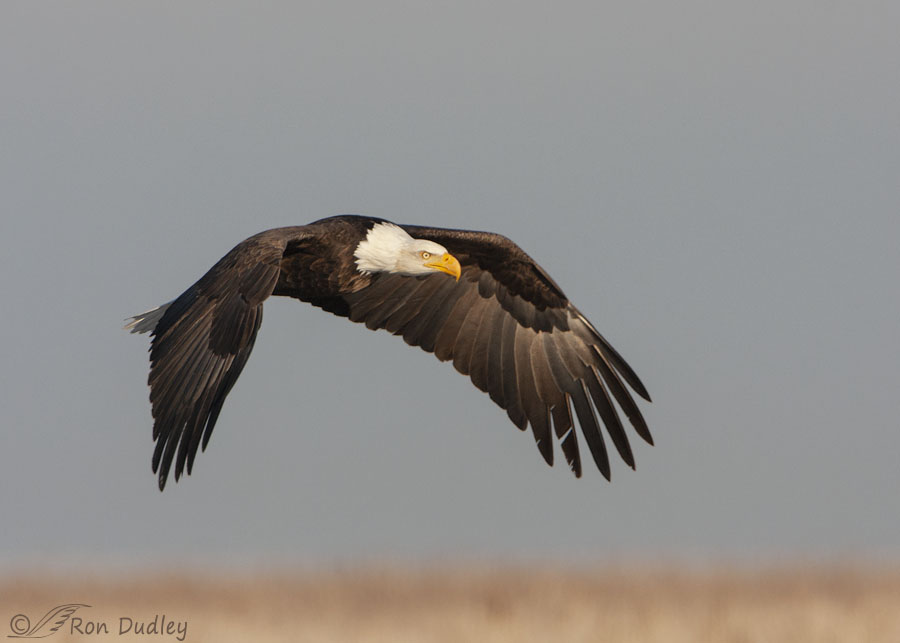The transformation of Bald Eagles from juveniles to adults typically takes about five years. The process is gradual but when you compare the juveniles (1st winter) to the adults and skip all the intermediate subadult stages the differences between them are dramatic.
I’ll use two photos from my archives to make the comparison. It happens that they were taken within one minute of each other, at 9:05 AM on February 2, 2009. It was a good morning for eagles.

1/1250, f/8, ISO 500, Canon 40D, Canon EF 500mm f/4L IS USM, not baited, set up or called in
Juvenile Bald Eagles are very dark brown, almost black, with varying amounts of white ventrally including lots of white in their axillaries (wingpits). Both bill and cere are blackish-gray and their eyes are dark brown, often appearing black.
It’s at this stage through some of the early subadult stages that many observers confuse younger Bald Eagles with Golden Eagles. When I’m in the field and some distance from the bird the most reliable field mark for distinguishing the two species is the distinctive golden nape of the Golden Eagle but Bald Eagles also have larger bills and that often helps too.

1/1600, f/8, ISO 500, Canon 40D, Canon EF 500mm f/4L IS USM + EF 1.4 Extender, not baited, set up or called in
Mature adult Bald Eagles are distinctive and unmistakable with their bright white heads and tails contrasting with nearly black bodies that lack the white splotching of younger birds (this adult is in warm light so its dark plumage has golden hues). By now the beak, cere and iris have turned fully bright yellow in stark contrast to the juvenile.
The differences between juveniles and adults are so dramatic that I sometimes marvel that they’re the same species, even though that trait is far from unique in the bird world.
Ron


Thanks for the interesting post and great photos. We are seeing more and more of these birds in Eastern Mass and it has been a pleasure. Now, if I can only land a decent photo!
I wish you luck in your quest, Joanne. Thanks.
Absolutely fantastic shots and amazing you could get both birds at exactly the same position! Total Genius Ron!
Charlotte
Thanks, Charlotte. I give the eagles themselves the credit for the very similar flight poses…
That is so interesting. Thanks Ron!
Thank you, Jean.
Wow. What a difference a (lot of) day(s) makes. I too am jealous of Frank’s trip to Alaska. And the eagles are only part of it.
“I too am jealous of Frank’s trip to Alaska”
EC, given the unusually oppressive heat you’ve had in Oz all summer I’ll bet Alaska in March sounds very good to you about now!
As usual, very nice lesson. Could you do a blog on the caparison of golden eagles and juvenile bald. When I am out in the field I am frequently asked by people who think the juv. bald are golden eagles.
Yesterday I went to the Gull Clinic given by the DNR at the new Eccles Wildlife Education Center in Farmington. The clinic was very good and informative about identifying gull types and stages of life.I hope they have more classes this one was top notch. I did not go out birding with the group, that is not my style but from this old time birder the presentation was superb! (Have I said that enough?) The center is beautiful and the staff very helpful. I LOVED your photos. They really add to the atmosphere of the education room. So lovely!
April, a little over a year ago I updated my post titled “Aging Bald Eagles” to include a section on the differences between immature (juvenile) Bald Eagles and Golden Eagles. Here’s the link:
https://www.featheredphotography.com/blog/2017/11/22/a-guide-to-aging-bald-eagles-and-how-to-distinguish-immature-bald-eagles-from-golden-eagles/
I’ve heard from others that the gull presentation was a very good one. And thank you for noticing and mentioning my prints in the auditorium of the new Wildlife Center. I’m happy to have them there.
Great views of the eagles! Here in south Florida the eagles hatch out in January, so they enter their fifth year in time for breeding that autumn when they are actually about 4 1/2 years old. At that age they may still have a few dark feathers in their head and tail. Four seasons back at our local nest such a female replaced a female which disappeared at the beginning of the nesting season, in October 2014. They copulated but she spent little time at the nest and seemed never to have a maternal instinct. She may even have laid one or more eggs, as the male seemed to be trying to incubate for several weeks, but no eaglets were produced. The next autumn she was right in stride and has raised young every year– even a second brood when a storm killed her first eaglet(s) only about a week after hatching. This year, her fourth successful season, she now has two eaglets.
Thanks, Ken. Yes, there can be significant variations in the timing of their plumage changes and maturity even in areas other than Florida. Some subadults can appear almost identical to adults and some over 5 years of age can still have dark streaking on their head. The plumage of older eagles doesn’t always correlate with their age.
Wow, Ron!! Brings back memories of my 1st year watching 3 eagle nests from hatch thru fledge. That being said I wanted to see the change from your Juvie above, to his appearance as an adult Eagle!! Once they fledged we only had rare sightings at the nests. That’s when I first “met” you, when one of my mentors at the Berry College Eagle nest told me to check out your blog on their age progression & here I am, 5 years later looking at an Eagle blog today!!! Thank you for all the joy you bring to all of us. Love to see your captures & learn from your blog!! By the way, yesterday I was at Green Cay to watch & photograph the birds & saw 4 Pied-bill Grebes together. I had to laugh since I told you I only see them singly!! The Lord heard my prayer!!
Interesting to hear your story about eagles and eventually finding Feathered Photography, Jo Ann. That post and a similar one I did later brought in a fair number of folks who continue to follow my blog.
Congrats on the multiple Pied-billed Grebe sighting.
Beautiful – the immature Bald’s and Golden’s are hard to sort out at times particularly without “glass” of some sorts……… We have a mature Bald and one or the other around at the moment – see them on road kill BUT when driving I’m not looking at the details! Went from 54 to 22 in about an hour yesterday afternoon! BRRRR! -2/fine snow/wind (not too bad) at present – “our turn”.
Went from 54 to 22 in about an hour yesterday afternoon! BRRRR! -2/fine snow/wind (not too bad) at present – “our turn”.
Judy, with my mediocre eyesight I often have trouble distinguishing them at greater distances. I carry binoculars for assistance in my pickup but rarely use them because my lens does a better job of it and it’s always handy.
That CA storm started to come in here yesterday and it’s raining this morning. We may get snow by tomorrow. Forecast for shooting looks like doodoo…
Nice post Ron. Great shots of both. Frank’s post above reminds me of a funny moment regarding eagles. When we moved to Prescott over twelve years ago one morning we were at the cafe overlooking Lynx Lake and were watching two soaring eagles through the windows. I asked the waitress if she ever takes time to go out and look at them. Her response was, “Honey, I used to live in Alaska.” That obviously said it all. I participated at Goldwater Lake in our annual eagle count on January 5th. We had two adults and 7 juvenile/immature eagles who were in various development stages from the pair born the previous year at Lynx Lake up to one that was maybe just a year away from full maturity. Was a real treat to get to see them all on that same morning.
Everett Sanborn, Prescott AZ
“Her response was, “Honey, I used to live in Alaska”
That’s funny, Everett. Yup, she needed to say nothing more.
If I’m lucky, hoping to get some great images.
Love Bald Eagles Ron, so much that I am headed to Homer Alaska the first week of March. Getting my warm clothes together!
Thanks for the post.
Hope you have a great trip and see lots of eagles, Frank. At Homer you should.
Frank, I am SO jealous!! Don’t envy you the cold you’ll be dealing with but with the huge number of Photographers there, you can all huddle together for some increased warmth!! Have an Eagleholic good time!!
In some places, like Haines, they are plentiful as pigeons in others…dangerous for small dogs and cats…